
Adolf Josef Ferdinand Galland was a German Luftwaffe general and flying ace who served throughout the Second World War in Europe. He flew 705 combat missions and fought on the Western Front and in the Defence of the Reich. On four occasions, he survived being shot down, and he was credited with 104 aerial victories, all of them against the Western Allies.

Walter Nowotny was an Austrian-born fighter ace of the Luftwaffe in World War II. He is credited with 258 aerial victories—that is, 258 aerial combat encounters resulting in the destruction of the enemy aircraft—in 442 combat missions. Nowotny achieved 255 of these victories on the Eastern Front and three while flying one of the first jet fighters, the Messerschmitt Me 262, in the Defense of the Reich. He scored most of his victories in the Focke-Wulf Fw 190, and approximately 50 in the Messerschmitt Bf 109. Nowotny scored an "ace in a day" on multiple occasions, shooting down at least five airplanes on the same day, including two occurrences of "double-ace in a day" in mid-1943.

Johannes "Macky" Steinhoff was a Luftwaffe fighter ace during World War II, German general, and NATO official. He was one of very few Luftwaffe pilots who survived to fly operationally through the whole of the war period 1939–45 until he was severely burned during a failed take-off. Steinhoff was also one of the highest-scoring pilots with 176 victories, and one of the first to fly the Messerschmitt Me 262 jet fighter in combat as a member of the Jagdverband 44 squadron led by Adolf Galland. Steinhoff was decorated with the Knight's Cross of the Iron Cross with Oak Leaves and Swords, and later received the Grand Cross of the Order of Merit of the Federal Republic of Germany and several foreign awards including the American Legion of Merit and the French Legion of Honour. He played a role in the so-called Fighter Pilots' Revolt late in the war, when several senior air force officers confronted Hermann Göring.

Heinrich Ehrler was a German Luftwaffe military aviator and wing commander during World War II. As a fighter ace, he is credited with 208 enemy aircraft shot down in over 400 combat missions. The majority of his victories were claimed over the Eastern Front, with nine claims over the Western Front which included eight in the Messerschmitt Me 262 jet fighter.

Gerhard "Gerd" Barkhorn was a German military aviator who was a renowned wing commander in the Luftwaffe during World War II. As a fighter ace, he was the second most successful fighter pilot of all time after fellow pilot Erich Hartmann. Other than Hartmann, Barkhorn is the only fighter ace to ever exceed 300 claimed victories. Following World War II, he became a high-ranking officer in the German Air Force of the Federal Republic of Germany.

Gordon Gollob was an Austrian fighter pilot during World War II. A fighter ace, he was credited with 150 enemy aircraft shot down in over 340 combat missions. Gollob claimed the majority of his victories over the Eastern Front, and six over the Western Front.
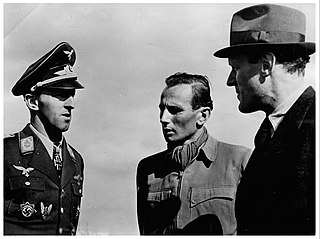
Hermann Graf was a German Luftwaffe World War II fighter ace. He served on both the Eastern and Western Fronts. He became the first pilot in aviation history to claim 200 aerial victories—that is, 200 aerial combat encounters resulting in the destruction of the enemy aircraft. In about 830 combat missions, he claimed a total of 212 aerial victories, almost all of which were achieved on the Eastern Front.
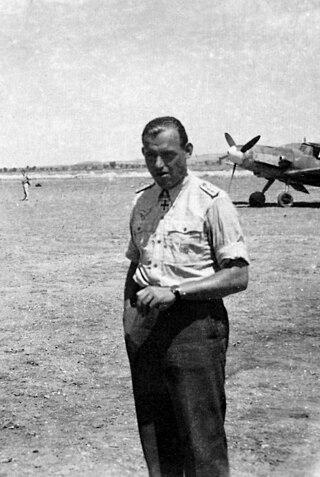
Oscar-Heinrich "Pritzl" Bär was a German Luftwaffe flying ace who served throughout World War II in Europe. Bär flew more than one thousand combat missions, and fought in the Western, Eastern and Mediterranean theatres. On 18 occasions he survived being shot down, and according to records in the German Federal Archives, he claimed to have shot down 228 enemy aircraft and was credited with 208 aerial victories, 16 of which were in a Messerschmitt Me 262 jet fighter. Sources credit him with 220 – 96 on Eastern Theatre and 124 on Western Theatre – up to 222 aerial victories may also be possible.
Heinz Wimmersal Sachsenberg was a German World War II fighter ace who served in the Luftwaffe. He was also a recipient of the Knight's Cross of the Iron Cross, the highest award in the military and paramilitary forces of Nazi Germany during World War II. Sachsenberg claimed 104 aerial victories.

Walter Krupinski was a German Luftwaffe fighter ace in World War II and a senior West German Air Force officer during the Cold War. He was one of the highest-scoring pilots in the war, credited with 197 victories in 1,100 sorties. He was called by his fellow pilots Graf Punski due to his Prussian origins. Krupinski was one of the first to fly the Messerschmitt Me 262 jet fighter in combat as a member of Jagdverband 44 led by Adolf Galland.
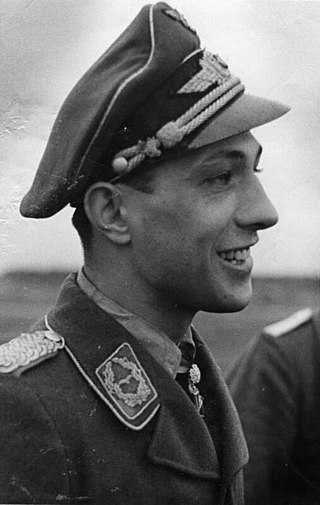
Erich Rudorffer was a German Luftwaffe fighter ace who was one of a handful who served with the Luftwaffe through the whole of World War II. He was one of the most successful fighter pilots in the history of air warfare, with 222 victories claimed. Rudorffer fought in all the major German theaters of war, including the European and Mediterranean Theater of Operations and the Eastern Front. During the war he flew more than 1000 combat missions, engaging in aerial combat over 300 times. Rudorffer was shot down by flak and enemy fighters 16 times and had to take to his parachute nine times.
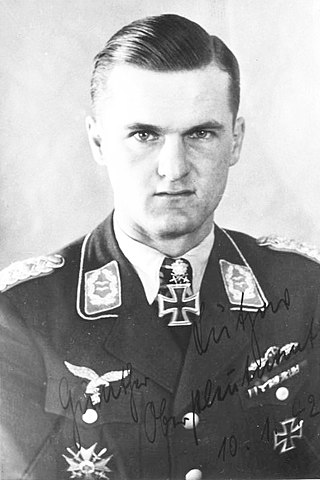
Günther Lützow was a German Luftwaffe aviator and fighter ace credited with 110 enemy aircraft shot down in over 300 combat missions. Apart from five victories during the Spanish Civil War, most of his claimed victories were over the Eastern Front in World War II. He also claimed 20 victories over the Western Front, including two victories—one of which was a four-engined bomber—flying the Messerschmitt Me 262 jet fighter.
The so-called Fighter Pilots' Revolt was a minor insurrection of a small group of high-ranking Luftwaffe pilots in early 1945, when they confronted Reich Marshal and chief of the Luftwaffe Hermann Göring with their demands on the conduct of the air war. Following the incident some officers were relieved of their positions or were reassigned.
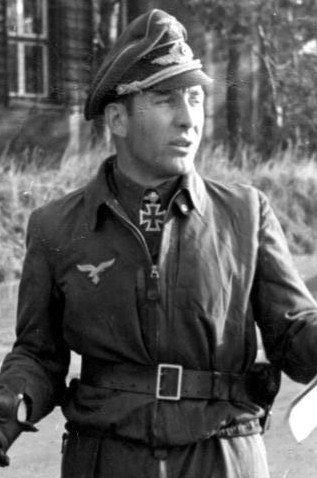
Theodor Weissenberger was a German Luftwaffe military aviator during World War II and a fighter ace credited with 208 enemy aircraft shot down in 375 combat missions. The majority of his victories were claimed near the Arctic Ocean in the northern sector of the Eastern Front, but he also claimed 33 victories over the Western Front. He claimed eight of these victories over the Western Allies while flying the Messerschmitt Me 262 jet fighter.

Dietrich Peltz was a German World War II Luftwaffe bomber pilot and youngest general of the Wehrmacht. As a pilot he flew approximately 320 combat missions, including roughly 130 as a bomber pilot on the Eastern Front, 90 as a bomber pilot on the Western Front, and 102 as a dive bomber pilot during the invasion of Poland and Battle of France.
Erich Hohagen was a German general in the Bundeswehr. During World War II, he served as a fighter pilot in the Luftwaffe. A fighter ace, Hohagen was credited with 56 aerial victories and was a recipient of the Knight's Cross of the Iron Cross, the highest award in the military and paramilitary forces of Nazi Germany during World War II.
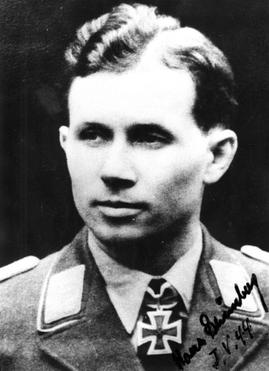
Hans "Specker" Grünberg was a German military aviator who served in the Luftwaffe during World War II. As a fighter ace, he was credited with 82, aerial victories—that is, 82 aerial combat encounters resulting in the destruction of the enemy aircraft—claimed in approximately 550 combat missions. The majority of his victories were claimed over the Eastern Front, with 21 claims over the Western Front, including five flying the Messerschmitt Me 262 jet fighter.
A Ergänzungs-Jagdgeschwader (EJG) were Luftwaffe replacement training units which were part of a larger operational Jagdgeschwader. The Germans were sometimes forced to undertake operations and training simultaneously. In 1944, the Luftwaffe formed two of these units, EJG 1 and EJG 2, by combining various training and experimental units. Its commanders included Viktor Bauer and Werner Andres.
Hermann Buchner was an Austrian-born Luftwaffe military aviator during the World War II, a fighter ace listed with 58 enemy aircraft shot down. A flying ace or fighter ace is a military aviator credited with shooting down five or more enemy aircraft during aerial combat. In total, Buchner is credited with 46 tank destroyed and 58 aerial victories, including 12 while flying the Messerschmitt Me 262 jet fighter, claimed in 631 combat missions. Following World War II, he became an officer in the Austrian Air Force.
Wilhelm Herget was a German Luftwaffe military aviator during World War II, a night fighter ace credited with 73—15 daytime and 58 nighttime—enemy aircraft shot down in over 700 combat missions. The majority of his victories were claimed over the Western Front in Defense of the Reich missions against the Royal Air Force's Bomber Command.














